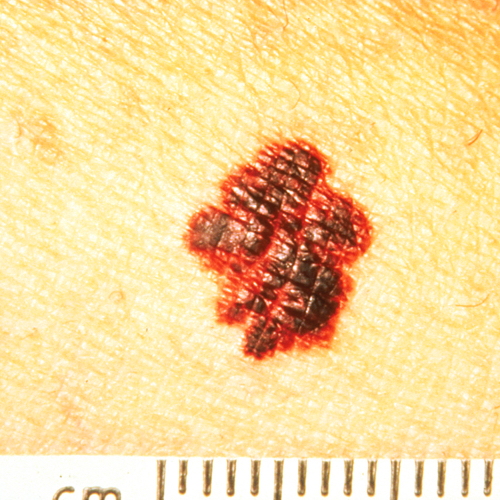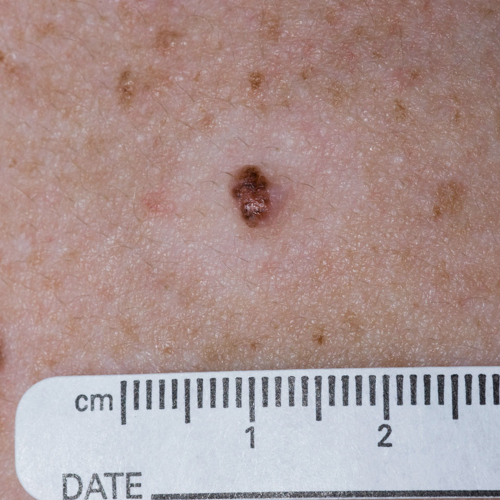What Does Melanoma Look Like?
Reviewed by: HU Medical Review Board | Last reviewed: May 2017. | Last updated: February 2023
The most common sign of melanoma is a new or changing skin lesion.1 Typical melanomas are brown or black (pigmented) lesions.2 Melanomas are often larger than normal moles. They may have an unusual shape and color. The ABCDE memory aid described below can help you identify possible melanomas.3,4 Another diagnostic trick is to look for an “ugly duckling.” An ugly duckling is a lesion that is obviously different from others.5
What does melanoma look like?
Importantly, melanoma appears in many different ways. There are four types of melanoma. Lesions typical of each type look different from each other. Additionally, some melanomas have atypical features. For example, some melanomas are colorless. The term for this is amelanotic melanoma. These tumors may be pink, red, tan, clear, or the color of normal skin.3,4 Some melanomas are smaller than 6 mm. Some melanomas develop in unusual locations. It can be difficult to diagnose melanoma with atypical features. Delayed diagnosis leads to delaying treatment.1
Melanoma





Some skin cancer experts recommend regular skin self-examinations.3,6 Self-examinations help you become familiar with the normal lesions on your body and better at spotting changes. Discuss changes in your skin with your primary care provider or dermatologist.
What are the ABCDEs of melanoma?
ABCDE can help you to remember the characteristics of a melanoma.3 Melanomas often have some or all of the ABCDE features.
ABCDE Memory Aid
What is an ugly duckling mole?
Everyone has moles and lesions. Your harmless moles and lesions probably look alike.7 Melanomas stick out from the crowd. Therefore, dermatologists look for the so-called “ugly ducklings.” This is another way of deciding if a mole or lesion is suspicious, even if it does not meet the ABCDE criteria above.
Figure 1. Spotting an ugly duckling
What do different types of melanoma typically look like?
Each type of melanoma has a different appearance.
Superficial spreading melanoma
Superficial spreading melanoma is the most common type of melanoma. It may look like a “brown-black stain that is spreading from a mole.”3 The lesion may grow outward slowly before invading deeper layers of skin.4
Nodular melanoma
Nodular melanoma grows vertically instead of outward. These tumors are firm, dome-shaped bumps.3 Typically they are blue to black in color. Rarely, they are pink or red.4
Lentigo maligna melanoma
Lentigo maligna melanoma may look like a stain on the skin.3,4 It often appears as a large, tan patch with an uneven border.3,4 Initially the lesion is flat, but it may become bumpy.
Acral lentiginous melanoma
Acral lentiginous melanoma can be hard to identify. It appears on palms, soles, knuckles, elbows, and knees.4 A subtype, called subungual melanoma, develops on finger nails and toe nails. Acral lentiginous melanoma may look like a bruise that does not go away. The lesion is usually black or brown. In rare cases, it is colorless (amelanotic or unpigmented).
Amelanotic melanoma
A small percentage of melanomas have little or no pigmentation.8 The tumor may look like a reddish patch or skin-colored lump.8 In one study of 20 amelanotic melanomas, the lesions did not have any of the typical ABCD features. They were symmetric circle/oval shapes, and they had regular borders.9 These tumors typically appear on sun-damaged skin.








